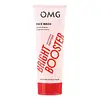What's inside
What's inside
 Key Ingredients
Key Ingredients

 Benefits
Benefits

 Concerns
Concerns

 Ingredients Side-by-side
Ingredients Side-by-side

Water
Skin ConditioningAcrylates Copolymer
Sodium Laureth Sulfate
CleansingSodium Lauroyl Sarcosinate
CleansingCocamidopropyl Betaine
CleansingPotassium Cocoyl Glycinate
Lactic Acid
BufferingPanthenol
Skin ConditioningPropylene Glycol
HumectantSodium Chloride
MaskingParfum
MaskingDMDM Hydantoin
PreservativeGuar Hydroxypropyltrimonium Chloride
Skin ConditioningGlycolic Acid
BufferingSalicylic Acid
MaskingDisodium EDTA
Vaccinium Myrtillus Fruit Extract
Skin ConditioningSaccharum Officinarum Extract
MoisturisingCitrus Aurantium Dulcis Fruit Extract
MaskingCitrus Medica Limonum Fruit Extract
Skin ConditioningAcer Saccharum Extract
Skin ConditioningWater, Acrylates Copolymer, Sodium Laureth Sulfate, Sodium Lauroyl Sarcosinate, Cocamidopropyl Betaine, Potassium Cocoyl Glycinate, Lactic Acid, Panthenol, Propylene Glycol, Sodium Chloride, Parfum, DMDM Hydantoin, Guar Hydroxypropyltrimonium Chloride, Glycolic Acid, Salicylic Acid, Disodium EDTA, Vaccinium Myrtillus Fruit Extract, Saccharum Officinarum Extract, Citrus Aurantium Dulcis Fruit Extract, Citrus Medica Limonum Fruit Extract, Acer Saccharum Extract
Water
Skin ConditioningGlycerin
HumectantStearic Acid
CleansingMyristic Acid
CleansingPotassium Hydroxide
BufferingLauric Acid
CleansingPropylene Glycol
HumectantGlyceryl Stearate
EmollientGlycol Distearate
EmollientDecyl Glucoside
CleansingKaolin
AbrasiveSodium Ascorbyl Phosphate
AntioxidantTocopheryl Acetate
AntioxidantNiacinamide
SmoothingOligopeptide-68
BleachingSodium Methyl Cocoyl Taurate
CleansingAllantoin
Skin ConditioningSodium PCA
HumectantPCA
HumectantSerine
MaskingAlanine
MaskingGlycine
BufferingGlutamic Acid
HumectantLysine Hcl
Skin ConditioningThreonine
Arginine
MaskingProline
Skin ConditioningGlycyrrhiza Glabra Root Extract
BleachingSodium Oleate
CleansingButylene Glycol
HumectantBetaine
HumectantSodium Lactate
BufferingGluconolactone
Skin ConditioningHydrogenated Lecithin
EmulsifyingParfum
MaskingDisodium EDTA
Ethylhexylglycerin
Skin ConditioningHydroxypropyl Methylcellulose
Emulsion StabilisingSodium Benzoate
MaskingPhenoxyethanol
PreservativePolyquaternium-7
Water, Glycerin, Stearic Acid, Myristic Acid, Potassium Hydroxide, Lauric Acid, Propylene Glycol, Glyceryl Stearate, Glycol Distearate, Decyl Glucoside, Kaolin, Sodium Ascorbyl Phosphate, Tocopheryl Acetate, Niacinamide, Oligopeptide-68, Sodium Methyl Cocoyl Taurate, Allantoin, Sodium PCA, PCA, Serine, Alanine, Glycine, Glutamic Acid, Lysine Hcl, Threonine, Arginine, Proline, Glycyrrhiza Glabra Root Extract, Sodium Oleate, Butylene Glycol, Betaine, Sodium Lactate, Gluconolactone, Hydrogenated Lecithin, Parfum, Disodium EDTA, Ethylhexylglycerin, Hydroxypropyl Methylcellulose, Sodium Benzoate, Phenoxyethanol, Polyquaternium-7
 Reviews
Reviews

Ingredients Explained
These ingredients are found in both products.
Ingredients higher up in an ingredient list are typically present in a larger amount.
Disodium EDTA plays a role in making products more stable by aiding other preservatives.
It is a chelating agent, meaning it neutralizes metal ions that may be found in a product.
Disodium EDTA is a salt of edetic acid and is found to be safe in cosmetic ingredients.
Learn more about Disodium EDTAParfum is a catch-all term for an ingredient or more that is used to give a scent to products.
Also called "fragrance", this ingredient can be a blend of hundreds of chemicals or plant oils. This means every product with "fragrance" or "parfum" in the ingredients list is a different mixture.
For instance, Habanolide is a proprietary trade name for a specific aroma chemical. When used as a fragrance ingredient in cosmetics, most aroma chemicals fall under the broad labeling category of “FRAGRANCE” or “PARFUM” according to EU and US regulations.
The term 'parfum' or 'fragrance' is not regulated in many countries. In many cases, it is up to the brand to define this term.
For instance, many brands choose to label themselves as "fragrance-free" because they are not using synthetic fragrances. However, their products may still contain ingredients such as essential oils that are considered a fragrance by INCI standards.
One example is Calendula flower extract. Calendula is an essential oil that still imparts a scent or 'fragrance'.
Depending on the blend, the ingredients in the mixture can cause allergies and sensitivities on the skin. Some ingredients that are known EU allergens include linalool and citronellol.
Parfum can also be used to mask or cover an unpleasant scent.
The bottom line is: not all fragrances/parfum/ingredients are created equally. If you are worried about fragrances, we recommend taking a closer look at an ingredient. And of course, we always recommend speaking with a professional.
Learn more about ParfumPropylene Glycol is an odorless, colorless liquid. As a humectant, it helps skin retain moisture. It also aids in delivering active ingredients.
Another role of this ingredient is preventing a product from melting or freezing. Propylene glycol also adds antimicrobrial properties to a product, elongating product lifespan.
This ingredient is considered an organic alcohol and commonly added into both cosmetics and foods.
Those with sensitive skin or conditions may develop a rash when using this ingredient.
Learn more about Propylene GlycolWater. It's the most common cosmetic ingredient of all. You'll usually see it at the top of ingredient lists, meaning that it makes up the largest part of the product.
So why is it so popular? Water most often acts as a solvent - this means that it helps dissolve other ingredients into the formulation.
You'll also recognize water as that liquid we all need to stay alive. If you see this, drink a glass of water. Stay hydrated!
Learn more about Water